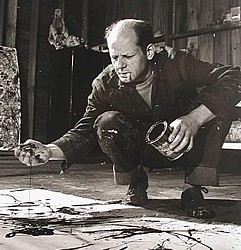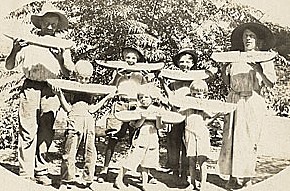|
JACKSON POLLOCK
Born January 28, 1912, Watkins Ranch, Cody, Wyoming
Died August 11, 1956, Springs, New York
On the floor I am more at ease, I feel nearer, more a part of the painting, since this way I can walk around it,
work for the four sides and be literally 'in' the painting.
--JACKSON POLLOCK, 1947
 American artist Paul "Jackson" POLLOCK was the youngest of five sons born to LeRoy and Stella May (McCLURE) POLLOCK, natives of
Tingley, Ringgold County, Iowa.
American artist Paul "Jackson" POLLOCK was the youngest of five sons born to LeRoy and Stella May (McCLURE) POLLOCK, natives of
Tingley, Ringgold County, Iowa.
In his book, Jackson Pollock: Energy Made Visible, B. H. FRIEDMAN notes: "Jackson Pollock's parents, Stella May
McClure and LeRoy Pollock were both in their late thirties when he was born, the mother a year older than the father. They had
been raised in Tingley, Iowa, and came from rather stern backgrounds, her Irish, his Scotch-Irish, both Presybterian. About
1890, the father, born McCoy, had taken the surname of his adoptive parents, neighbors of his natural parents, who had both
died within a year. As a boy, LeRoy Pollock learned frontier skills - mainly ranching, farming, and later, surveying - by which,
with difficulty, he supported his wife and sons. "There is nothing in his background or in the external facts of his life which would make
one predict that all five of his sons would want early in life to become artists. Charles (Cecil) Pollock (1902-1988) is a painter who also
taught art; (Marvin) Jay Pollock (1904-1986) is a rotogravure etcher*; Frank (Leslie) Pollock (1907-1994) studied writing, though he became a rose
farmer, and Sanford (LeRoy) "Sande" Pollock (1909-1963), who changed his last name to McCoy, was a painter, rotogravure platemaker, seriographer, and silk
screen printer*. . .
*[FRIEDMAN's assessment of Marvin Jay's and Sanford LeRoy's pursuits in art are in error. Marvin Jay
was the rotogravure platemaker. Sanford was a seriographer, which is the same thing as a silk screen printer.]
"Some members of the family trace [the Pollock boys' creativity] to Stella Pollock's interest in weaving,
crocheting, and quilting. She was also an excellent seamstress and made shirts for the entire family. However, in all this work one sees
competence and craft. . . Stella, the "cottage weaver," stayed within a framework of folk conventions and given patterns. As one
studies family pictures of her. . . a large full-busted woman, always erect and stern. In contrast, pictures of LeRoy Pollock are
typically relaxed and smiling. [ A member of the Pollock family contacted me, saying, "I have never seen a photograph of LeRoy that looked relaxed and smiling." - Sharon R. Becker]
His face and body suggest a gentleness and sensitivity, a warmth rubbed a little raw, that
may well have been the product of hard abrasive years. Before working at the sheep ranch in Cody [Wyoming], he had been a dishwasher
at the Irma Hotel there, then a plasterer, then partner in a stone-crushing plant. When (Paul) Jackson was born, LeRoy's
occupation was listed on the birth certificate as 'stone mason and cement work.'
". . . .Stella Pollock worried maybe even more than her husband, about the details of managing family affairs. . . however she liked
beautiful things. . . Perhaps because of LeRoy Pollock's lack of 'business sense,' perhaps because of a more profound and unconscious
restlessness, the family was constantly on the move during Jackson's childhood. Before he was one they had left Cody to
settle in San Diego. That didn't work out. The next year his father bought a small truck farm in Phoenix. Within four years it was
auctioned [off] and the Pollocks moved to a fruit farm in Chico, California, and then, within four more years, to yet another in Janesville,"
California where the POLLOCKS bought the Diamond Mountain Inn. "In October of 1920, LeRoy separated* from the family but maintained
contact with them by sending letters and checks once a month and visiting on holidays. The family reunited in May of 1923 and returned to
Phoenix.
[The Pollock family contacted me, saying, "LeRoy did not “separate” from the family in the usual sense of the word, he went wherever he could find work and when he was on road-building and surveying jobs, he was not 'at home'." Which was typical of the era. The father followed work to support the family while
the mother maintained a home base, providing stability for the children, not only in their home life but in their educational pursuits. - Sharon R. Becker]
 At Right: The POLLOCK Family eating watermelon, Arizona, 1914
At Right: The POLLOCK Family eating watermelon, Arizona, 1914
L-R: LeRoy, Frank, Charles, Jackson, Jay, Sanford, Stella
While accompanying his father on surveying trips with road crews around the vicinity of the Grand Canyon, Jackson was exposed to Native American culture which many believe
later was the basis of his inspiration for his technique of painting. Jackson attended Manual Arts High School in Los Angeles. Here, Jackson
discovered alcohol and began his life-long battle with the bottle. His behavior, perhaps fueled by alcohol,
caused him to be expelled from school. Following his
brother Charles to New York, Jackson began to study painting in 1929 at the Art Students' League under Regionalist painter Thomas Hart BENTON. From
1938 to 1942, Jackson worked for the WPA Federal Art Project but by the mid-1940's, he had begun to paint in the abstract "drip and splash"
style for which he is best known. Jackson was strongly supported by critics - and at the same time subjected to considerable
sarcasm. In 1956, Time Magazine referred to him as "Jack the Dripper." By the 1960's, Jackson was generally recognized as the most
important figure in the most important movement of American painting, commonly referred to as Post-Painterly Abstraction. "In October of 1945, Jackson married to Lee KRASNER (1911-1984), an Abstract Expressionist painter of some distinction. The couple
moved to what is now known as the Pollock-Krasner House and Studio in Springs, Long Island, New York. The house was purchased
with a loan given to them by Jackson's mentor, Peggy GUGGENHEIM. "Jackson battled with
depression and alcoholism.
Because of this battle, Jackson did not paint at all in 1955." Jackson died at the age of 44 in an alcohol-related single car crash when his
Oldsmobile convertible hit a tree on August 11, 1956. The car crash occurred less than a mile from his home in Springs, New York.
Edith METZGER, a passenger in the car was also killed in the crash. Jackson's friend Ruth KLIGMAN, however, survived the
crash. [Ruth KLIGMAN moved in with Jackson during Lee's absence when she went to Europe. Edith METZGER was Ruth's friend.] Jackson's premature death in part contributed to him becoming a legend. Lee, Jackson's wife,
managed his estate, assuring that Jackson's reputation remained strong in the ever-changing art world. She also achieved
serious critical recognition as an artist after Jackson's death. Lee and Jackson are interred at Green River Cemetery,
Springs, New York. A large boulder marks Jackson's gravesite and a smaller one marks Lee's. Ruth KLIGMAN (1930-2010) published a book entitled Love Affair: A Memoir of Jackson Pollock. She lived in
New York and was involved in creating new work. A biographical film Pollock was released in 2000, earning
Marcia Gay HARDEN the Academy Award for Best Supporting Actress for her portrayal of Lee KRASNER. The film was a project of
actor Ed HARRIS who not only directed the film but portrayed Jackson POLLOCK, which earned him a nomination for the
Academy Award for Best Actor. Jackson's 1952 Blue Poles: Number 11 is estimated to be worth between $100 and $150
million and is housed at the National Gallery of Australia. His work, No. 5, 1948 became the world's most expensive
painting when it was sold in November of 2006 to an undisclosed buyer [rumored to be a German businessman and art collector]
for the sum of $140,000,000.
Stella Mae (McCLURE) POLLOCK was born in a two-room log cabin, Tingley, Iowa, May of 1875.
Stella's father was a mason and a carpenter, and her mother was a weaver. Known for her skillful abilities, Stella
was making dresses by the time she reached her teen years, selling the garments to the wealthier women in town. Stella
died in 1958 and was interred at Tingley
Cemetery, Ringgold County, Iowa.
Gravestone of Stella (McClure) Pollock, Tingley Cemetery
photograph by Tony Mercer
LeRoy POLLOCK, a 1895 graduate of Tingley High School, was born in 1876. After contracting malignant endocarditis,
a bacterial infection of the valves of the heart, LeRoy died three months later on March 6, 1933.
James M. POLLOCK, LeRoy's adoptive father, was born in 1835. He served during the Civil War with
Company G of the 36th Regiment of Illinois Volunteers, and died on November 28, 1909, with
interment at
Tingley Cemetery. Elizabeth "Lizzie" POLLOCK was born in 1838, and died in 1906.
1895 GRADUATES, TINGLEY HIGH SCHOOL
photograph courtesy of Janet Ann (PALMER) PROCTOR
BRAWNER
granddaughter of Nellie Mae (PALMER) PROCTOR, seated front row at the right
Front Row, Far Left: LeRoy POLLOCK
Back Row, 2nd from Left: Daniel McGUGIN, Anna McCLURE (sister of Stella), center
Ringgold County Ancestors of Jackson POLLOCK
SOURCES:
FRIEDMAN, B. H. Jackson Pollock: Energy Made Visible, P.4, 1995.
www.ibiblo.org/wm/paint/auth/pollock/
en.wikipedia.org/wiki/Jackson_Pollock
en.wikipedia.org/wiki/Ruth_Kligman
moma.org/exhibitions/1998/pollock/website100/chronology.html
additional information from the Pollock family
Compiled and Submitted by Sharon R. Becker, 2008; edited and updated 2010
BIOGRAPHICAL SKETCHES INDEX


|


